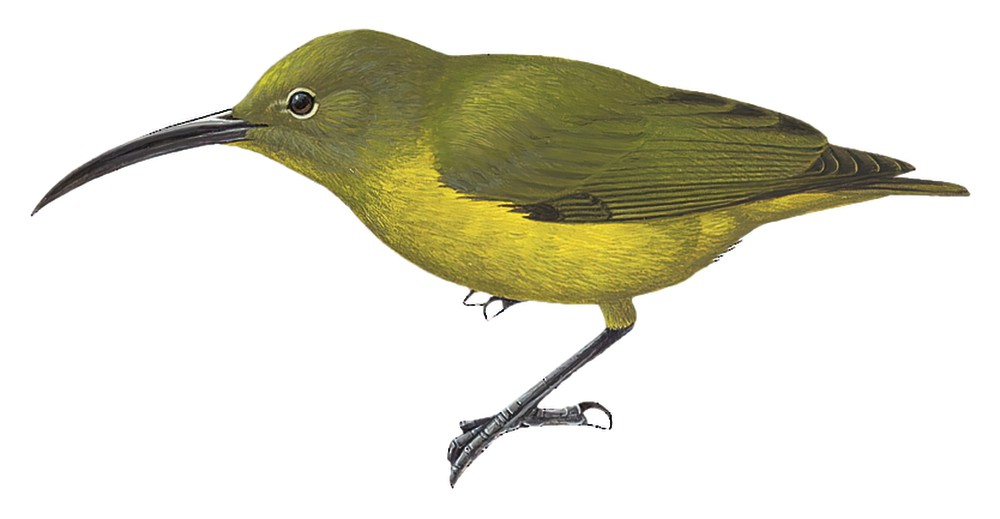Yellow-bellied Longbill / Toxorhamphus novaeguineae

Yellow-bellied Longbill
SCI Name:
Protonym: Cinnyris NovaeGuineae Dict.Sci.Nat. 50 p.22
Taxonomy: Passeriformes / Melanocharitidae / Toxorhamphus
Taxonomy Code: yeblon1
Type Locality: Dorey [= Manokwari] , northwestern New Guinea.
Author: Lesson
Publish Year: 1827
IUCN Status: Least Concern
DEFINITIONS
TOXORHAMPHUS
(Melanocharitidae; Ϯ Yellow-bellied Longbill T. novaeguineae) Gr. τοξον toxon bow; ῥαμφος rhamphos bill; "Toxorhamphus 1 gen. nov. Genuscharakter: Meliphagiden von Arachnothera-artigen Habitus. Schnabel lang, länger als Tarsus und Cranium, mit langer, nicht von Federn bedeckter, im proximalen Teil durch ein Operculum völlig bedeckbarer Nasengrube. Kanten den Oberschnabels im Endteil gezähnt oder unregelmässig gezackt. Augengegend mit normal entwickelten Federn ganz bedeckt. Schwanz die Flügel nur wenig überragend; seine Länge beträgt stets weniger als 2/3, meist etwa ½ der Flügellänge. ♀ beträchtlich kleiner als ♂. Kleine Formen (Flügel etwa 60-70 mm.). Typus: Cinnyris novaeguineae Lesson. ... 1 Tοξον = arcus, ῥαμφος = rostrum." (Stresemann 1914).
novaeguinae / novaeguineae / novaeguineensis
L. novus new; Mod. L. Guineensis Guinean < Guinea Guinea, West Africa; i.e. New Guinea (first named Nueva Guinea in 1545 by the Spanish explorer Ortíz de Retes, because aborigines in the Mamberano region reminded him of those he had encountered earlier in African Guinea).
● ex “Lori noir de la Nouvelle Guinée” of Sonnerat 1776, and “Black Lory” of Latham 1781 (syn. Chalcopsitta atra).
● ex “Choucas de la Nouvelle Guinée” of d’Aubenton 1765-1781, pl. 269, and “New-Guinea Crow” of Latham 1781 (syn. Coracina striata).
● Erroneous TL. New Guinea (= New South Wales); ex “Grand Martin-pêcheur de la Nouvelle Guinée” of Sonnerat 1766, “who had received the specimen from Cook’s botanist, Joseph Banks, at Cape Town. Sonnerat had never travelled to either New Guinea or Australia” (Robin 2001) (Dacelo).
● ex “Crabier de la Nouvelle Guinée” of d’Aubenton 1765-1781, pl. 926, “Crabier noir” of de Buffon 1770-1786, and “New Guinea Heron” of Latham 1785 (syn. Egretta sacra).
● ex “Caille de la nouvelle Guinée” of Sonnerat 1776, and “New Guinea Quail” of Latham 1783 (unident.).
SUBSPECIES
Yellow-bellied Longbill (novaeguineae)
SCI Name: Toxorhamphus novaeguineae novaeguineae
novaeguinae / novaeguineae / novaeguineensis
L. novus new; Mod. L. Guineensis Guinean < Guinea Guinea, West Africa; i.e. New Guinea (first named Nueva Guinea in 1545 by the Spanish explorer Ortíz de Retes, because aborigines in the Mamberano region reminded him of those he had encountered earlier in African Guinea).
● ex “Lori noir de la Nouvelle Guinée” of Sonnerat 1776, and “Black Lory” of Latham 1781 (syn. Chalcopsitta atra).
● ex “Choucas de la Nouvelle Guinée” of d’Aubenton 1765-1781, pl. 269, and “New-Guinea Crow” of Latham 1781 (syn. Coracina striata).
● Erroneous TL. New Guinea (= New South Wales); ex “Grand Martin-pêcheur de la Nouvelle Guinée” of Sonnerat 1766, “who had received the specimen from Cook’s botanist, Joseph Banks, at Cape Town. Sonnerat had never travelled to either New Guinea or Australia” (Robin 2001) (Dacelo).
● ex “Crabier de la Nouvelle Guinée” of d’Aubenton 1765-1781, pl. 926, “Crabier noir” of de Buffon 1770-1786, and “New Guinea Heron” of Latham 1785 (syn. Egretta sacra).
● ex “Caille de la nouvelle Guinée” of Sonnerat 1776, and “New Guinea Quail” of Latham 1783 (unident.).
Yellow-bellied Longbill (flaviventris)
SCI Name: Toxorhamphus novaeguineae flaviventris
flaviventer / flaviventre / flaviventris
L. flavus yellow, golden-yellow; venter, ventris belly.
● ex “Ortolan à ventre jaune du Cap de Bonne Espérance” of d’Aubenton 1765-1781, pl. 664, fig. 2 (Emberiza).
● ex “Petit Râle de Cayenne” of d’Aubenton 1765-1781, pl. 847 (Hapalocrex).
● ex "Ypacahá ceja blanca" of de Azara 1802-1805, no. 377 (syn. Hapalocrex flaviventer).
● ex “Coucou à ventre rayé de l’Île Panay” of Sonnerat 1776 (syn. Hierococcyx sparverioides).
● ex “Tachurí vientre amarillo” of de Azara 1802-1805, no. 171 (Pseudocolopteryx).
● ex “Tangara tacheté de Cayenne” of d’Aubenton 1765-1781, pl. 290, fig. 2 (syn. Tangara mexicana).
UPPERCASE: current genus
Uppercase first letter: generic synonym
● and ● See: generic homonyms
lowercase: species and subspecies
●: early names, variants, mispellings
‡: extinct
†: type species
Gr.: ancient Greek
L.: Latin
<: derived from
syn: synonym of
/: separates historical and modern geographic names
ex: based on
TL: type locality
OD: original diagnosis (genus) or original description (species)












